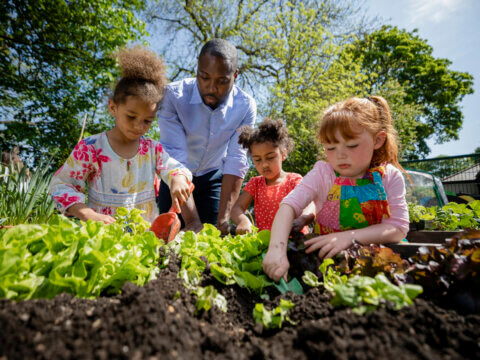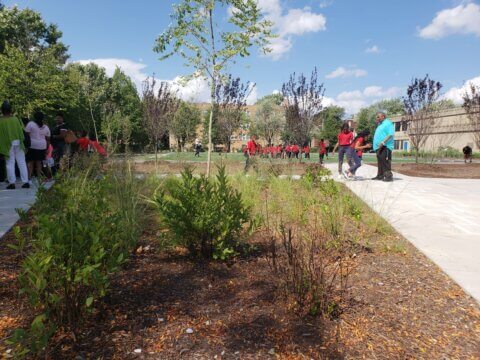In search of a greener schoolyard: As the planet heats up, green schoolyards offer a world of benefits
On a hot summer day, time seems to slow to a crawl, and our instinct is to head indoors, shelter in the air conditioning and drink something nice and cool. But for school kids, the answer isn’t so simple. Outdoor play is an intrinsic part of learning, and being able to run, jump, chase and shoot hoops is what makes the day-to-day grind livable, especially during the transition back to school. As global temperatures climb, schoolyards that aren’t accessible due to heat are a serious challenge for kids and educators alike.
Researchers, educators, and school districts are working on ways to meet this challenge — and many of those ways involve bringing more nature into schoolyards that have historically been little more than pavement and turf.
“We’re looking at large-scale tree planting, we’re looking at gardens, nature trails, nature play infrastructure like climbing logs, ponds, solar, greenhouses… it really runs the gamut,” says Melody Alcazar. Alcazar is the program manager for the Cities Connecting Children to Nature (CCCN) initiative in the city of Austin, Texas. “We do a lot of community engagement about what features seem appropriate for that community, and then work to fund and install those specific features.”

Interactive features can make a green schoolyard more accessible and inviting. Photo: Austin Parks and Recreation Department.
To better understand the impact of greener, nature-filled schoolyards, a team of experts launched a research project in 2018 that gathered data from Austin-area elementary schools. The team’s findings were published in a 2022 report titled Heat-Resilient Schoolyards: Relations Between Temperature, Shade, and Physical Activity of Children During Recess, in the Journal of Physical Activity and Health.
Research data was collected through temperature and humidity analysis, combined with the measurement of activity levels in students, at three elementary schools. For the activity measurements, children’s movements were recorded by accelerometers, while their location (and proximity to shade and natural features) was measured by GPS.

Austin, Texas-based researchers used weather stations to collect temperature and humidity measurements at various spots on playgrounds while researching the impact of green schoolyards on physical activity. Photo: Green Schoolyards Project.
Among the conclusions of the research: green playgrounds can offer oases of cooler temperatures, and temperature plays a major role in how much kids play — or whether they play at all. “At one park, the hottest spot in the park was a 114-degree heat index,” says study lead author Dr. Kevin Lanza, an assistant professor at the UTHealth Houston School of Public Health. “Just about 100 feet south, it was the coolest spot in the park, at 103 degrees,” says Lanza.
According to the U.S. Department of Energy, shade and evaporation processes from trees can reduce the air temperature around them by as much as 6ºF. And, because “cool air settles near the ground, air temperatures directly under trees can be as much as 25°F cooler than air temperatures above blacktop,” which is found on many playgrounds in the U.S.
In short: tree canopy and other natural features including water and interactive gardens can reduce heat effects, help kids play outdoors and stay connected with nature in hot weather.
THE GREEN SCHOOLYARD STACK EFFECT
Green schoolyards have obvious benefits for kids, offering settings that are cooler and more stimulating than traditional playgrounds. But their impact is much deeper than it might initially appear.
“Trees not only clean our air, they not only provide shade, they not only filter our stormwater, but they also provide us a level of happiness and stress relief,” says Lanza. Greener schoolyards, he adds, offer a sort of stacked benefit to communities. They help broaden access to nature, can teach kids about food and farming, reduce the urban “heat island” impact of asphalt and concrete, mitigate the impact of flooding and provide sanctuaries for pollinators. “When we say there’s no such thing as a panacea … vegetation comes to be the closest thing to that,” he says.

A garden pond installation at Discovery Hill Outdoor Learning Center helps students better understand the natural ecosystems around them. Photo: Austin Independent School District.
The connection between mental health and outdoor play is well-established by research, which makes the Austin findings even more important in context — outdoor play is no luxury for kids. It’s a necessity.
“What we found in our published results is that when temperatures increased, activity decreased and children sought shade,” says Lanza. “It was around 91 degrees Fahrenheit where children were more likely to not engage in physical activity. School recess is meant to be a mental break where children can be active and play and interact, and this has been shown to be a calming strategy for kids re-entering the classroom. This brings us to our major recommendations: we should be greening our schoolyards and adding more shade.”

Children play on a natural structure at Wooldridge Elementary School in Austin, Texas. Photo: Austin Parks and Recreation Department.
Priya Cook, the Children & Nature Network’s Director of Green Schoolyards & Healthy Communities, sees yet another benefit from greening schoolyards: their impact on air quality.
“In some of the communities we’ve worked with, there are air quality concerns, and those can be environmental justice concerns,” says Cook. “In school sites – like one we’re working with in Dearborn, Michigan – that are across the street from heavy industrial operations, there’s a lot of particulate matter in the air. Tree canopy and greenery can help filter particulate matter and make it healthier for people in the area to breathe.”
All of the benefits that come along with greener schoolyards are multiplied due to a sheer sense of scale. Schools, note the researchers, are major landowners in urban areas — sometimes the biggest landowners, with dozens or hundreds of acres under their jurisdiction. A change across a city’s schoolyards can transform the dynamics of an entire urban area.
INCREASING EQUITABLE ACCESS TO NATURE
The Austin research focused on elementary schools serving predominantly Latino communities and communities with limited economic resources. One of the underlying goals of the research: broadening access to high-quality nature so kids of all backgrounds can play in and connect with the natural world. For many kids, this means making nature accessible through school and neighborhood parks.
“We’re hyper-focused on how racial equity is influenced by this, and we’ve learned a lot of lessons in the past five years,” says Alcazar. She notes that an ongoing goal of building greener schoolyards is also increasing access and equity when it comes to nature-based play. “It’s about building stronger and deeper community connections. There’s a lot of trust that has been lost with the city and district, and it’s going to take some intentional work to build that back up.”

Extreme heat is a barrier to children's physical activity, and it disproportionately impacts BIPOC kids. Photo: Texas School Physical Activity and Nutrition Survey.
Cathy Jordan, Consulting Director of Research for the Children & Nature Network, says that increasing access to nature for kids of all walks of life is crucial and part of a complex basket of benefits that come along with greening schoolyards. “You might think you’re doing it for one reason, but you have the opportunity to make a difference across human development, community vitality, ecology, stormwater infrastructure, climate adaptation… It’s really unique,” she says.
1 Comment
Submit a Comment
“Effects of trees, gardens, and nature trails on heat index and child health: Design and methods of the Green Schoolyards Project” – a scientific paper on the design of the Austin Green Schoolyards Project
Additional journal articles about the Austin Green Schoolyards Project: ”Connection to nature is associated with social-emotional learning of children”, and “School parks as a community health resource: use of joint-use parks by children before and during covid-19 pandemic”
A brochure with an overview of the Austin Green Schoolyards Project
Read more about the Austin Children’s Outdoor Bill of Rights
Research Digest: Global Lessons for Green Schoolyard Design and Pedagogy
Global Lessons on Greening School Grounds & Outdoor Learning, a joint initiative to transform school grounds around the world
Green Schoolyard Design Features, a photo gallery
-
Voices
CAMPING WHILE PARENTING: A Mother-Son Adventure
-
Feature
A common thread: Indigenous-led foundation weaves together activism and art, climate and community
-
Network News
Community Spotlight: Prescribe Outside
-
Voices
That’s nice, mija: Finding common language in nature connections
-
Richard Louv
"HUMMINGBIRD PARENTS": Seven Actions Parents Can Take To Reduce Risk And Still Get Their Kids Outside







This is a great article that highlights the importance of green schoolyards. The author does a good job of explaining the benefits of green schoolyards, such as their ability to reduce heat, improve air quality, and provide children with opportunities to connect with nature. I am particularly interested in the research project that was conducted in Austin, Texas, which found that children who had access to a greener schoolyard were more physically active during recess. I think this is a very important finding, as it shows that green schoolyards can help to improve the health and well-being of children.